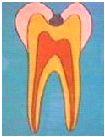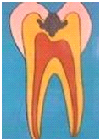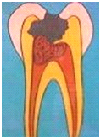Cavities Fillings and Root Canal Treatment

Tooth decay is one of the most common dental problems. It occurs in all age groups including children, teens and adults. This is of because of plaque, a sticky film of bacteria, which constantly forms on your teeth. When you eat or drink foods containing sugars or starches, the bacteria in plaque produce acids that attack tooth enamel. The stickiness of the plaque keeps these acids in contact with your teeth and after many such attacks, the enamel can break down and a cavity forms.
TREATMENT FOR DENTAL CAVITIES

When decay is limited to enamel: Treatment at this initial stage is preventive in nature because it will stop the decay process from extending to deeper areas of the tooth. All that is necessary is a simple filling. It is usually painless at this stage. Your dentist will clean out the decayed part of enamel and fill the resulting cavity with either silver amalgam, or preferably, with the newer tooth coloured composite material.

When decay has extended to dentin: This may be painful after eating or with cold water. Food is likely to be lodged in the cavity. Treatment at this stage consists of a more extensive filling. It may be necessary to numb the area during treatment. One of the above materials may be used.

When decay has reached the nerve: Serve pain is the usual complaint. The invading bacteria cause the nerve of the tooth to become inflamed. Root canal treatment will be necessary at this stage if the tooth has to be saved.

Infection reaches bone: The bacteria destroy the nerve and spread to the bone of the jaw. The bone is thus inflamed and infected. The infection may erode through the side of the bone into the mouth, face or neck to cause a swelling.
ROOT CANAL TREATMENT
When a tooth becomes infected , pulpectomy i.e removal of the pulp tissue, is advisable to prevent spread of infection. Usually, some inflammation and/or infection is already present within or below the tooth. To cure the infection and save the tooth, the dentist drills into the pulp chamber and removes the infected pulp and then drills the infection out of the root canal(s) with long needle-shaped drills. After this is done, the dentist fills each of the root canals and the chamber with an inert material and seals up the opening. This procedure is known as root canal therapy. With the removal of infection from the tooth, it is best that the tooth be fitted with a cap or crown to protect the tooth from breakage.













 044 - 24816078
044 - 24816078



